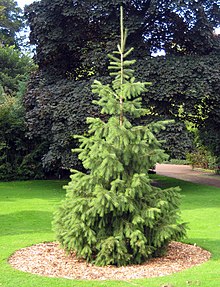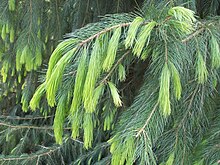| Morinda spruce | |
|---|---|

| |
| Morinda spruce at Royal Botanic Garden Edinburgh | |
| Conservation status | |
 Least Concern (IUCN 3.1) | |
| Scientific classification | |
| Kingdom: | Plantae |
| Clade: | Tracheophytes |
| Clade: | Gymnospermae |
| Division: | Pinophyta |
| Class: | Pinopsida |
| Order: | Pinales |
| Family: | Pinaceae |
| Genus: | Picea |
| Species: | P. smithiana |
| Binomial name | |
| Picea smithiana (Wall.) Boiss. | |
| Synonyms | |
|
Abies khutrow (Royle ex Turra) Loudon | |
Picea smithiana is a species of evergreen tree in the family Pinaceae family. It is referred to by the common names morinda spruce and West Himalayan spruce, and is a spruce native to the western Himalaya and adjacent mountains, from northeast Afghanistan, northern Pakistan, India to central Nepal. It grows at altitudes of 2,400-3,600 m in forests together with deodar cedar, blue pine and pindrow fir.
Description

Picea smithiana is a large tree, an evergreen growing to 40–55 meters tall (exceptionally to 60 m), and with a trunk diameter of up to 1–2 m. It has a conical crown with level branches and usually pendulous branchlets.
The shoots are pale buff-brown, and glabrous (hairless). The leaves are needle-like, the longest of any spruce, 3–5 cm long, rhombic in cross-section, mid-green with inconspicuous stomatal lines. The cones are broad cylindric-conic, 9–16 cm long and 3 cm broad, green when young, maturing buff-brown and opening to 5–6 cm broad 5–7 months after pollination; the scales are stiff and smoothly rounded.
Morinda spruce is a popular ornamental tree in large gardens in western Europe for its attractive pendulous branchlets. It is also grown to a small extent in forestry for timber and paper production, though its slower growth compared to Norway spruce reduces its importance outside of its native range. The name morinda derives from the tree's name in Nepali.
Etymology
Picea means 'pitch', and is derived from the ancient Latin word of the same meaning, pix. The name is in reference to the sticky sap produced by members of this genus.
Smithiana is named for James Edward Smith, an English botanist and the founder of the Linnaean Society.
References
- Farjon, A.; Rushforth, K. (2013). "Picea smithiana". IUCN Red List of Threatened Species. 2013: e.T42338A2973761. doi:10.2305/IUCN.UK.2013-1.RLTS.T42338A2973761.en. Retrieved 19 November 2021.
- ^ "Picea smithiana (Wall.) Boiss". Plants of the World Online. The Trustees of the Royal Botanic Gardens, Kew. n.d. Retrieved 18 September 2020.
- BSBI List 2007 (xls). Botanical Society of Britain and Ireland. Archived from the original (xls) on 26 June 2015. Retrieved 17 October 2014.
- "Picea smithiana". Germplasm Resources Information Network. Agricultural Research Service, United States Department of Agriculture. Retrieved 9 August 2018.
- Huxley, A., ed. (1992). The new Royal Horticultural Society dictionary of gardening.
- "Picea smithiana - Plant Finder". www.missouribotanicalgarden.org. Retrieved 10 March 2024.
- ^ Gledhill, David (2008). "The Names of Plants". Cambridge University Press. ISBN 9780521866453 (hardback), ISBN 9780521685535 (paperback). pp. 302,
External links
| Taxon identifiers | |
|---|---|
| Picea smithiana |
|
| Pinus smithiana | |